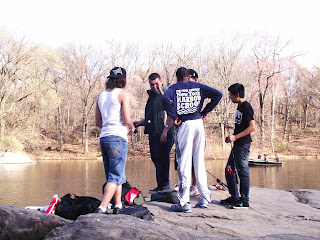(Photos: -- Fishermen at the Boat Lake this past week. They kept the fish out of the water at least five minutes and only threw the fish back when I took out camera. 2-- Mama and Papa at Boat Lake yesterday. But, will these two already lame geese be safe from discarded fishing lines carelessly left around grounds and pedestrian paths?)
They arrive in the spring and they stay and stay and stay until seemingly the last summer leaf has fallen to the ground.
No, I am not talking about geese or ducks or robins.
I am talking about the fishermen whose presence in Central Park is already marked by a crippled sea gull at Harlem Meer hobbling around with at least six feet of fishing line attached to his/her leg.
The gull can however still fly, making rescue to remove the fishing line (or even getting a good photo) nearly impossible.
During the past week, I have noted fisherman trespassing the "off limit" areas of Central Park, smoking cigarettes (supposedly not allowed in city parks), leaving empty soda bottles in the grass and keeping captured fish out of the water for at least five minutes while the fishermen strike poses and hog for photos.
A few days ago a guy was fishing off the small dock at Turtle Pond. There were at least 30 turtles in the water where the man slowly lowered his fishing line.
"Are you trying to hook a turtle?" I asked, perturbed by what I was seeing.
"There's a bass somewhere down there." the man replied belligerently.
"You shouldn't be fishing directly where there is an abundance of wildlife." I answered, annoyed at that point.
"I am within my rights to fish here!" the man shot back.
"Well, fishing at Turtle Pond was NEVER allowed in years past and shouldn't be now!" I answered while taking out my camera to take a photo of ducks.
"You can't take a picture of me!" the man shouted defensively.
"I wasn't planning to!"
I wanted to add, "You ugly jerk!" but didn't.
Instead, I walked away as the confrontation was beginning to get nasty.
Still, while witnessing all these infractions this past week, it was the crippled seagull at Harlem Meer that finally propelled me on a journey of seemingly endless calls to various city and state agencies to register a complaint about abusive and unmonitored fishing in Central Park.
One tends to discover in "bureaucracy" situations like this, one gets shuffled around and constantly advised to call someone else.
And so, in less than two days, I talked to a Park Ranger, officials from the DEC, Central Park Conservancy, Dept of Parks and Recreation, the Dana Discovery Center (located at Harlem Meer) and registered an official complaint with 311.
I am normally a person who never complains to city and park officials about anything.
But, the slaughter campaigns against geese over the past few years and the continual crippling and harassment of wildlife in our city parks by fishermen has turned me into a kind of crusader.
Of the people I spoke with, a woman from the DEC (Department of Environmental Conservation) and another woman from the Dept. of Parks and Recreation were the most helpful, supportive and offering of sound advice.
That advice being that one indeed has to become the persistent "squeaky wheel" and immediately report ALL violations first, to 311 and to the other agencies in charge of managing wildlife and law enforcement in the parks.
(The DEC has a special number to report fishing violations when immediately witnessed: 1(800) TippDEC. 1(800) 847-7332.)
"They will put their resources where they are most demanded and required." I was advised.
I indeed hope that is the case.
Because another summer of watching crippled birds hobbling around with fishing lines on their legs, hooked turtles and discarded fishing lines left on pedestrian paths and grass to ensnare dogs or humans (as occurred with my dog, Tina and me last summer) is simply intolerable and unacceptable.
Become the eyes and mouths for the wildlife in your parks and be sure to snap photos when possible and make the appropriate calls.
We all have to become the "squeaky wheels" for the fish, turtles and birds who cannot defend themselves nor remove the fishing lines ensnared around and crippling their bodies and feet. -- PCA
*************
























